![]()
![]()
![]()
Use LEFT and RIGHT arrow keys to navigate between flashcards;
Use UP and DOWN arrow keys to flip the card;
H to show hint;
A reads text to speech;
34 Cards in this Set
- Front
- Back
|
In high heat and light is C3 carbon fixation still efficient?
|
no, rubisco can fix oxygen instead of carbon dioxide to the RuBP molecule.
|
|
|
What happens to the RuBP + O2?
|
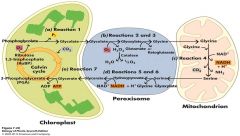
forms PGA + 2PG..
- PGA is converted to GAP and used by ox. resp. - 2PG goes through a salvage pathway that recycles the 2PG (is able to recover 1 carbon but uses lots of ATP) |
|
|
Photorespiration:
|
a process in plant metabolism by which RuBP (a sugar) has oxygen added to it by the enzyme (rubisco), instead of carbon dioxide during normal photosynthesis. This process reduces efficiency of photosynthesis in C3 plants.
|
|
|
In photorespiration, 2 x 2-PG becomes what, and what is lost?
|
1 x 3PGA, and one CO2 is lost. therefore 1 of 10 carbons is lost overall.
|
|
|
does warm weather or tropical weather affect the efficiency of photosynthesis in plants?
|
yes by about 50 to 90%
|
|
|
Why does photorespiration exist?
|
because under high oxygen, oxygen becomes a effective competitive inhibitor of rubisco binding carbon dioxide.
|
|
|
Is there any possible ways plants minimize oxygen binding of rubisco?
|
yes, it has to do with leaf anatomy combined with physiology... [evolution and adaptation]
|
|
|
C3 leaf anatomy:
|
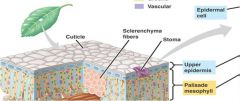
(outside in)
1. outside: waterproof and nearly gas proof, waxy coating called a cuticle 2. 1st cellular layer: epidermis (physical barrier). - generally a single layer of closely interlocking cells - do not allow passage of water or gas between cells. |
|
|
Stomata of C3 leaf:
|
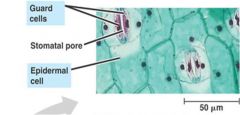
located in lower epidermis.
- tiny holes to interior of leaf - are flanked by 2 guard cells that can open or close to allow gas or water vapor exchange with atmosphere - generally found only on the lower epidermis to min. water loss |
|
|
Mesophyll of C3 anatomy:
|
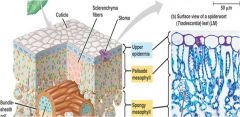
- is sandwhiched between the upper and lower epidermis.
- composed of photosynthetic parenchyma cells - (upper half) palisade parenchyma which carry out light rxn's. - (lower half) where C/B cyc. is carried out. generally in spongy arrangement with airspaces that are cont. with stomata... helps to scatter light that reaches through as well as promotes better gas exchange. |
|
|
Vascular tissue in the mesophyll:
|
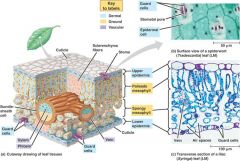
- continuous with vasc. tissue of the stem.
- repeatedly subdivides from the central vein into smaller and smaller veins and ramify through out the leaf. - increased surface area increases gas/nutrient exchange between cells and vessels. - gives structural support to the leaf - found within the spongy mesophyll. |
|
|
summary of C3 leaf anatomy:
|
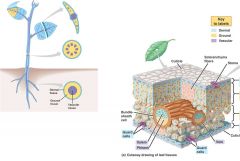
|
|
|
When does the problem with rubisco binding O2 instead of CO2 occur?
|
- in hot weather when stomata closes cutting off CO2 supply from outside.
- light reaction still occurs, leading to a build up of O2 in the leaf - Ox. resp. wont use up all the O2, nor generate enough CO2 to compensate for the high O2 concentration through out the whole day. - leads to a favor of binding O2 over CO2 with rubisco. |
|
|
How do you increase the CO2 concentration with the stomata are closed or nearly closed?
|
C4 anatomy and metabolism
|
|
|
C4 leaf anatomy:
|
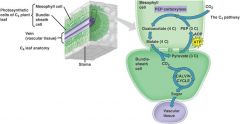
Very similar to C3 leaves both have:
-cuticle -epidermis -stomata - palisades -spongy mesophyll -veins |
|
|
What's the difference between C4 and C3 leaves:
|
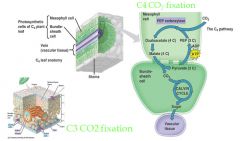
- mesophyll is arranged differently
- there are photosynthetic bundle sheath cells. |
|
|
What are some physiological tricks carried out to concentrate the carbon dioxide in C4?
|
- under high heat cond. the spongy mesophyll is inhibited from carbon fixation by the limitation of rubisco
- veins are directly surrounded by a layer of bundle sheath cells and then a layer of palisades mesophyll - since the palisades cells are so tightly packed together, the gases will have a harder time diffusing from the palisades to the bundle sheath cells (incl. CO2 and O2) |
|
|
describe the process of C4 fixation:
|
1. CO2 dissolves in water [CO2 + H2O --> HCO3- + H+]
2. palisades cells have an enzyme called PEP carboxylase (HCO3- is the substrate for PEP carboxylase, not CO2). [PEP CO2ase: HCO3- + PEP --> oxaloacetate (C4). ] 3. PEPCO2ase doesn't confuse CO2 with O2 like rubisco does. |
|
|
Cont. of C4 fixation process:
|
4. Palisades cells fix CO2 into OAA
- then C4 plants use NADP dependent malic enzyme to convert OAA into malate (in mesophyll) - malate difuses into the bundle sheath cells via the plasmodesmata. 5. bundle sheath cells then deCO2late malate --> Pyr + CO2 6. pyr diffuses back to palisades cells to participate in the cycle again. 7. CO2 has been delivered to bundle sheath cells, deep in the leaf away from O2 8. C/B occurs in the bundle sheath cells. |
|
|
What are the effects of C4 fixation:
|
- by malate dumping off CO2 in the bundle sheath cells, has the effect of concentrating CO2 in the bundle sheath.
- [CO2] is now high enough to be fixed by rubisco in the bundle sheath and the C/B cyc. funcitons in teh bundle sheath only. - once photosynthate is made, it is loaded into the pholem. |
|
|
What are some C4 plants?
|
tropical grasses like:
-maize -carbgrass -sugarcane |
|
|
What happens with rubisco does combine RuBP with O2?
|
photorespiration occurs
- in hot tropical conditions, with the light reaction running hard and the dark reaction inhibited, ATP and NADPH will be accumulating and these are reactive compounds. - photorespiration uses up ATP and NADPH thus it gets rid of excess. |
|
|
What happens to the 2C compound (2-PG)?
|
through a complex pathway that involves reacitons from the chloroplast the the perodisome and mitochnodrion, 2C compound is converted into PGA in the salvage pathway of photorespiration.
|
|
|
the salvage pathway of photorespiration:
|
|
|
|
the salvage pathway of photorespiration:
|
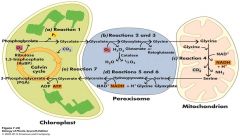
|
|
|
Why hasn't photorespiration been eliminated by evolution?
|
1. maybe rubisco cant bind to CO2 without sometimes binding to O2
2. maybe photorespiration makes biochemicals that can not be made any other way. 3. photorespiration uses ATP and NADPH thus is a sink for these compounds in these specific conditions and gets rid of excess 4. photorespiration may be involved in nitrogen fixation. |
|
|
CAM:
|
Crassulacean acid metabolism.
- occur in some plants which deal with high heat and lack of water - only lose 50 to 100g of water by transpirtion through stomata per g of photosynthase made compared to 250 to 500g in C4 and C3. - CAM plants have a competitive advantage in scarce water environment. - IS PRIMARILY ABOUT MIN. WATER LOSS |
|
|
What plants have CAM metabolism:
|
- cacti
- succulents like agave - pinapple |
|
|
How does CAM metabolism min. daytime water loss, while still allowing photosynthesis to cont. ?
|
1. accomplishes the task of fixing C in desert conditions in which stomata are closed.
- uses temporal separation of cellular activities. In the night (open stomata) - biochemical reaciton in CAM are similar to C4. - in the cytosol, PEP carboxylase meidates [HCO3- + PEP --> OAA] - OAA is reduced by NADPH to malate and then malate is stored in the vacule. In the day (closed stomata, no water or gas exchange) - malate is transported to the chloroplast releasing CO2. - with increase concentration of CO2, trapped inside the leaf C/B cyc. occurs in the bundle sheath cells. |
|
|
Comparison of C4 and CAM:
|
C4: spacial seperation, minimizes photorespiraiton
CAM: temporal separation, min. water loss |
|
|
comparison of C4 and CAM:
|
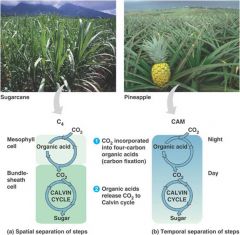
C4: spacial separation, min. photorespiraiton
CAM: temporal separation, min. water loss. |
|
|
How is this wholesale change in CAM metabolic activity regulated?
|
1. the regulation of the CAM day/night cycle is a good example of how organism uses enzymes to regulate physiology.
2. Mechanism's that function to regulate various activities like this one are used in all eukaryotic cells and the principles behind them are all the same. |
|
|
How do plants make sure to make malate during the night and turn off C/B cyc. during the day when there is no CO2 available?
|
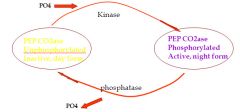
1. they control it by regulation of the activity of PEP carboxylase.
2. PEP carboxylase is the enzyme that converts PEP to OAA. It is probably an allosteric enzyme and it exists in 2 forms. - can be unphosphorylated (day time) is inactive and is inhibited by malate [ allosteric inhibitor] - can be phosphorylated (night form) is active and is not inhibited by malate. |
|
|
What happens to PEPCO2ase during CAM metabolism regulation?
|
1. (in the day) enzyme is not phosphorylated, is inhibited by malate and activates C/B cycle by feeding it C as malate from vacuole.
2. (in night): enzyme is phosphorylated, is not inhibited by malate and stores C as malate in vacuole. |

